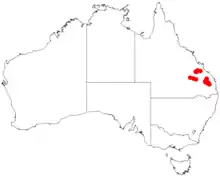Acacia holotricha
Acacia holotricha is a shrub belonging to the genus Acacia and the subgenus Phyllodineae that is native to parts of north eastern Australia.
| Acacia holotricha | |
|---|---|
| Scientific classification | |
| Kingdom: | Plantae |
| Clade: | Tracheophytes |
| Clade: | Angiosperms |
| Clade: | Eudicots |
| Clade: | Rosids |
| Order: | Fabales |
| Family: | Fabaceae |
| Clade: | Mimosoideae |
| Genus: | Acacia |
| Species: | A. holotricha |
| Binomial name | |
| Acacia holotricha | |
 | |
| Occurrence data from AVH | |
Description
The shrub or tree typically grows to a height of 5 to 10 m (16 to 33 ft). It has ribbed, dark coloured branchlets with linear or widely ovate stipules that are 3 to 6 mm (0.12 to 0.24 in) in length. Like most species of Acacia it has phyllodes rather than true leaves. The narrowly elliptic evergreen phyllodes have a length of 12 to 17 cm (4.7 to 6.7 in) and a width of 3 to 6 cm (1.2 to 2.4 in) and are unequal at the base and acute at the apex with a prominent midrib prominent and lateral nerves. When it blooms it produces inflorescences with seven to ten headed racemes along an ais with a length of 3 to 10 mm (0.12 to 0.39 in) with spherical flower-heads containing around fifty yellow flowers. Following flowering thinly coriaceous seed pods are produced that have a linear shape and are rounded over and constricted between the seeds. The pod have a length of up to 18 cm (7.1 in) to 18 cm long with longitudinally arranged seeds inside.[1]
Taxonomy
The species was first formally described by the botanist Leslie Pedley in 1980 in the work A revision of Acacia Mill. in Queensland as published in the journal Austrobaileya. It was reclassified by Pedley in 1987 as Racosperma holotrichum then transferred back to genus Acacia in 2001.[2]
Distribution
The shrub has a limited distribution in south eastern Queensland from atound Taroom in the south and up to around Duaringa in the north.[1]
See also
References
- "Acacia holotricha". World Wide Wattle. Western Australian Herbarium. Retrieved 10 May 2019.
- "Acacia holotricha Pedley". Atlas of Living Australia. Global Biodiversity Information Facility. Retrieved 13 June 2020.